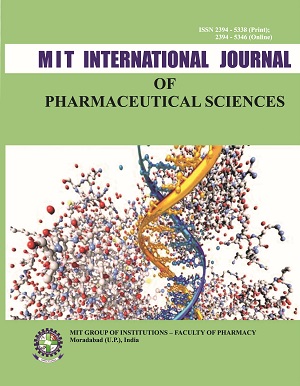
MIT INTERNATIONAL JOURNAL OF PHARMACEUTICAL SCIENCES (MITIJPS)
ISSN 2394-5338 (Print); 2394-5346 (Online)
Volume 7, Issue 2, 2022
This is open access Journal
Global Impact factor:0.565
SJIF Impact factor: 5.296
MITIJPS
Volume 5, Issue 1, 2019
Original Article
Histopathological and immunohistochemical studies on the effects of Ethephon on liver and kidney in male rats
Ehab Tousson*, Afaf El-Atrsh, Merfaat Mansour, Abdallah Assem
Zoology Department, Faculty of Science, Tanta University, Egypt.
*Corresponding Author: Tel.:+ 00201002282382, E-mail: toussonehab@yahoo.com
Abstract
Ethephon can release ethylene which could affect the plant growth process. The current study was designed to study the possible toxic effects of ethephon on both liver and kidneys of male rats. 20 adult male rats were divided into 2 groups; the first group is control and the second group received Ethephon at dose (200 mg/kg body weight/day) for four weeks. At the end of the study liver and kidney tissues were taken and examined histopathologically. Ethephon administration to rats showed marked injury in liver and kidney. Also, liver and kidney sections in treated rats with Ethephon showed strong positive affinity for PCNA expressions. These results indicated that Ethephon could be harmful on liver and kidney. Producers and consumers should become more aware about the toxic effects of Ethephon.
Keywords: Ethephon, Plant growth regulator, Toxicity, Liver and kidney, PCNA
Original Article
Does blood group affect people taking swimming as a hobby?
Muhammad Imran Qadir, Tooba Komal*
Institute of Molecular Biology and Biotechnology, Bahauddin Zakaria University Multan, Pakistan.
*Corresponding Author: Tel.: +92 3126531381, E-mail: toobaansari246@gmail.com
Abstract
Objective of the present study was to co-relate blood grouping with the choice of taking swimming as a hobby. A total of 173 subjects participated in the present study. The subjects were the students of Bahauddin Zakariya University Multan, Pakistan. Blood group systems are the classification of the blood groups on the base of presence or absence of antigens on the surface of RBCs. Antigens can be A, B, AB and if no antigen is present, blood type will be O. These blood types can determine the physical nature of the subjects that which blood type people are likely to choose swimming as a hobby. It was concluded from the present study that A- blood type subjects are more likely to choose swimming as a hobby and B+ are least likely to take swimming as a hobby.
Keywords: Blood group, Swimming, Hobby, Study
Original Article
Development of polyherbal formulation for immunomodulation
P.K. Fulwadea,*, J.B. Kandaleb, S. S. Bhujbalc
aRasiklal M. Dhariwal College of Pharmacy, Chinchwad Station, Pune, Maharashtra, India.
bM. C. E. Society’s Allana College of Pharmacy, K.B. Hidayatullah Road, Azam Campus, Pune, Maharashtra, India.
cDr. D. Y. Patil College of Pharmaceutical Sciences and Research, Pimpri, Pune, Maharashtra, India.
*Corresponding Author: Tel.: +96 57926502, E-mail: pratibhads081@gmail.com
Abstract
A polyherbal formulation was prepared by using methanolic extract of Sphaeranthus indicus flowerheads, fruits of Piper nigrum, hydroalcoholic extracts of Withania somnifera, Ocimum sanctum, Centella asiatica for immunomodulatory activity. The effects of 100 mg, 200 mg, 400 mg were screened on humoral and cellular immunity i.e. delayed type hypersensitivity on mice. The mice were also subjected to cyclophosphamide induced myelosupression. The present study demonstrated that the formulation 200 mg, 400 mg have synergistic immunostimulant activity in HA titre, DTH, on lymphoid organ weight and it also showed protection against cyclophosphamide induced myelosupression.
Keywords: Sphaeranthus indicus, Withania somnifera, Piper nigrum, Immunomodulation, Delayed type hypersensitivity
Original Article
The choice between sweet and salty taste according to blood groups
Muhammad Imran Qadir, Fatima Hameed*
Institute of Molecular Biology and Biotechnology, Bahauddin Zakariya University Multan, Pakistan.
*Corresponding Author: Tel.: +92 3065073323, E-mail: fatimagill26@gmail.com
Abstract
The objective of the present study was to correlate blood grouping with the choice between sweet and salty taste. Total of 176 students were participating in the present study. The subjects were students in Bahauddin Zakariya University Multan, Pakistan. A blood group system is the classification based on the presence or absence of antigens on the red blood cells (RBC’s) surface. The antigens may be A, B, AB and if there is no antigen on RBC’s so blood group is O. The other system is RH system that contains RH antigens or inherited proteins that are found on the surface of RBC’s. These blood groups show which type of subject is more likely to eat salty food and which blood type subjects like sweet food. It shows how blood groups affect the likeness and dislikeness of subjects between sweet and salty taste. From the present study it was concluded that more people likes salty food to eat instead of sugary food.
Keywords: Blood grouping, Sweet and salty taste, Taste buds, DNA
Original Article
Pharmacognostic, phytochemical investigation & pharmacological study of young leaves of Triticum aestivum Linn
Vijay Nigam
Medical Data Collection, Analysis & Patient Follow up Department-PCU, Patanjali Yogpeeth, Haridwar, Uttarakhand.
*Corresponding Author: Tel.: +91 9589285006, E-mail: vijay.nigam@divyayoga.com
Abstract
The aim of the work is to perform the pharmacognostic study of the leaves of plant Triticum aestivum Linn. Family Poaceae, commonly known as ‘Wheatgrass’. It is cultivated on large scale all over India and also occasionally cultivated in garden. For the present study samples of the Wheatgrass leaves were collected over a specific period of nine days. The drug was cultivated with specific type of hybrid seeds obtained from most reputed institution of India and were scrupulously analysed. For standardization of the herbal drug morphological, phytochemical, physicochemical and microscopical examination was done. The leaves grown were found to be lax, cauline, flat, 0.6 to 0.25 inches (4 to 6 mm) wide, 6-9 inches long and green in colour. The chemical compositions of the leaves are proteins, flavonoids, alkaloids, glycosides, terpenoides, saponins, fibres, tannins and phenolic compounds. The plant juice is the mainly used for cancer alignment and main source of medicine used along with Basil, mint & Neem leaves to reduce toxicity & cancer cells.
Keywords: Triticum aestivum grass, Wheatgrass, Physicochemical & microscopical examination, Phytochemical screening, Standardization, Cancer
Original Article
Comparison of student’s knowledge about trachoma disease and its treatment
Comparison of student’s knowledge about Muhammad Imran Qadir, Sadia Batool*
Institute of Molecular Biology and Biotechnology, Bahauddin Zakariya University, Multan, Pakistan.
*Corresponding Author: Tel.: 03216841235, E-mail: sadiamalik97979797@gmail.com
Abstract
The objective of the present study was to compare the student’s knowledge about Trachoma disease and its treatment. In the present study total 100 subjects participated. The subjects were students in Bahauddin Zakariya University, Multan, Pakistan. A questionnaire was prepared, questions were asked from subjects and then their knowledge compared about trachoma disease and its treatment. It was concluded that most subjects confirmed that trachoma is a bacterial disease and it can transfer through contact. Mostly subjects were not sustained from trachoma. Mostly said, it can mediated by medicine and not by the surgery. But the fact is that it can be mediated by both medicine and surgery.
Keywords: Trachoma disease, Treatment, Comparison
Original Article
Oral Insulin Delivery: A New Approach
Sanjay K. Mishra*, M. K. Gupta
Department of Pharmacy, Oriental University, Indore, Madhya Pradesh.
*Corresponding Author: Tel.:+91 8319136734, E-mail: mishra_sanjay87@rediffmail.com
Abstract
Oral delivery is the preferred route of administration because it offers several advantages over other routes. However, it is not an effective route for the delivery of peptides and proteins because of so many constraints. The small intestine has been shown to be able to transport the L-forms of amino acids against a concentration gradient and that they compete for the mechanism concerned. So L-Valine was used as a ligand for carrier mediated transport of insulin loaded PLGA nanoparticles. L-valine-conjugated PLGA-nanoparticles were prepared using double emulsion solvent evaporation method. The insulin bearing nanoparticles were also studied for size, drug entrapment efficiency, zeta potential and polydispersity index, in-vitro insulin release. In-vivo studies were performed on streptozotocin induced diabetic rabbits. Oral suspension of insulin loaded PLGA nanoparticles reduced blood glucose level from 265.4±8.5 to 246.6±2.4 mg/dl within 4 hrs which further decreased to 198.7±7.1 mg/dl value after 8 hrs. Compared with formulation loaded with the drug, the valine conjugated nanoparticles produced a sustained hypoglycaemic response till 12 hrs than 8 hrs. Hence, it is concluded that the L-valine conjugated NPs bearing insulin are the promising carrier for the transportation of insulin across the intestine on oral administration.
Keywords: L-valine, Streptozotocin, PLGA nanoparticles, Insulin
Review Article
An overview on fluoroquinolone drugs for the treatment of tubercular infection
Mohammad Asif*
GRD (PG) IMT, 214, Rajpur Rd, IAS Officers Colony, Rajpur, Dehradun, Uttarakhand, India.
*Corresponding Author: E-mail: aasif321@gmail.com
Abstract
The fluoroquinolones-levofloxacin, moxifloxacin and gatifloxacin have potent bactericidal activities against Mycobacterium tuberculosis. They have the potential activity in managing both drug-susceptible and drug-resistant tuberculosis as well as the possibility of shortening the period of therapy. The emergence of drug-resistance, fluoroquinolone-resistant, multidrug-resistant and extensively drug-resistant tuberculosis created a challenge to control the tuberculosis globally. The newer fluoroquinolones have clinical efficacy in some of the patients. So, it is needed the utility of new fluoroquinolone drugs for the treatment of tuberculosis.
Keywords: Fluoroquinolones, Levofloxacin, Moxifloxacin, Gatifloxacin, Tuberculosis
Short Communication
Amazing health benefits of Moringa Oliefera and Rosa Canina
Sarika Gupta, Kislaya Mishra*
Hygia Institute of Pharmaceutical Education and Research, Prabandh Nagar, Lucknow, India.
*Corresponding Author: Tel.: +91 7800020461, E-mail: kisalayamishra@yahoo.in
Abstract
Moringa Oliefera and Rosa Canina are well known plant for their high nutritive and medicinal value. Moringa Oliefera is also known as drumstick or horseradish tree. Moringa leaves are very rich source of vitamins, antioxidants, iron etc. The plant is a boon for poor people suffering from malnutrition. It is also helpful for lactating mothers. It is rich in macro and micro nutrients like protein, carbohydrate, calcium, phosphorus, potassium, iron, vitamins, beta carotene and other bioactive compounds which are important for normal functioning of the body and prevention of certain diseases. Rosa canina L. is a perennial shrub that belongs to Rosacea family. Rosa canina L. has been used for long years as a source of vitamins, medicinal supplements, and food throughout the world. It contains various vitamins (especially vitamin C) and other valuable compounds such as polyphenols, carotenoids, carbohydrates and fatty acids. The medicinal properties of rose hip in the symptomatic treatment of osteoarthritis, rheumatism and common cold are discussed in this paper. Moreover, there are evidences about anti-bacterial, anticancer, anti-diabetic and anti-obesity properties of this medicinal plant that have been reviewed in this article.
Keywords: Drumstick tree, Osteoarthritis, Rheumatism, Carotenoids, Lactation, Malnutrition
